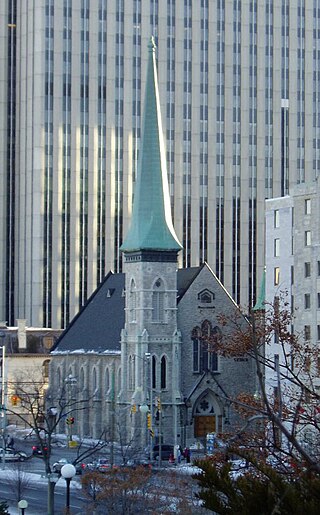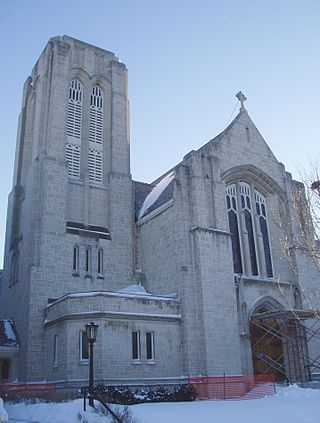
Lisgar Collegiate Institute is an Ottawa-Carleton District School Board secondary school in Ottawa, Ontario, Canada. The school is located in downtown Ottawa by the Rideau Canal.

Cumberland is a former municipality and now geographic township in eastern Ontario, Canada. It was an incorporated township from 1800 to 1999, when it was incorporated as the City of Cumberland, then ceased to be a separate municipality in 2001, when it was amalgamated into the city of Ottawa. It now exists only as a geographic township.

The Governor General's Foot Guards (GGFG) is the senior reserve infantry regiment in the Canadian Army. Located in Ottawa at the Cartier Square Drill Hall, the regiment is a Primary Reserve infantry unit, and the members are part-time soldiers.

Edward James Gibson Holland was a Canadian recipient of the Victoria Cross, the highest and most prestigious award for gallantry in the face of the enemy that can be awarded to British and Commonwealth forces, for actions taken during the Second Boer War in South Africa.

The Drill Hall at Cartier Square is a dedicated military training facility in Ottawa, Ontario, Canada. It has been a local landmark since its construction in 1879. The drill hall is 70 metres (230 ft) long and has two 43-metre-tall (141 ft) mansard towers.

First Baptist Church is a Baptist church in Ottawa, Ontario, Canada. It is affiliated with the Canadian Baptists of Ontario and Quebec.
The Peace Tower is a focal bell and clock tower sitting on the central axis of the Centre Block of the Canadian parliament buildings in Ottawa, Ontario. The present incarnation replaced the 55-metre (180 ft) Victoria Tower, after the latter burned down in 1916, along with most of the Centre Block; only the Library of Parliament survived. It serves as a Canadian icon and had been featured prominently on the Canadian twenty-dollar bill, directly adjacent to the depiction of Queen Elizabeth II, until the change to polymer.

St. Bartholomew's Anglican Church is a place of worship in Ottawa, Ontario, Canada. The building was constructed in the latter half of the 19th century and serves the surrounding neighbourhoods. Additionally, St. Bartholomew's is, due to its location next to Rideau Hall, the place of worship for various Governors General of Canada and some members of the Canadian Royal Family. It is also the regimental chapel of the Governor General's Foot Guards.

St Matthew's Anglican Church is an Anglican church in the Glebe neighbourhood of Ottawa, Ontario, Canada. It was founded in 1898 and is among the oldest Anglican parishes in central Ottawa.

Centretown United Church is an historic church located in Ottawa, Ontario, Canada at 507 Bank Street at Argyle in the Centretown area. It was built in 1906 as the Stewarton Presbyterian Church using Gothic Revival architecture under the architecture of Moses Chamberlain Edey, (designer of Heritage site the Aberdeen Pavilion and the Daly Building. The corner stone was laid by Sir Mortimer Clarke, Lieutenant Governor of Ontario. Centretown United Church is a member church of the United Church of Canada.

Christ Church Cathedral is the Anglican cathedral in Ottawa, Ontario, Canada. The church is located at 414 Sparks Street in the northwest section of the city's downtown at the western end of Sparks Street on top of a promontory looking down to the Ottawa River.

St Patrick's Basilica is a Roman Catholic Church in Ottawa, Ontario, Canada. Located at 281 Nepean Street in Downtown Ottawa, it is the oldest church in the city that serves the English-speaking community. The Basilica is one of the regular buildings featured in the Doors Open Ottawa architectural heritage day.

The 87th Battalion, CEF was a Household Foot Guards infantry unit in the Canadian Expeditionary Force during the First World War.

The Dominion of Canada Rifle Association is a Canadian shooting sports organization governing fullbore target rifle disciplines. The Association was founded in 1868 and incorporated by an Act of Parliament 63-64 Victoria Chapter 99, assented to July 7, 1900, to promote and encourage the training of marksmanship throughout Canada.

St. Joseph's Parish is a Roman Catholic parish church located in Ottawa, Ontario, Canada. It is an Anglophone congregation located very near its partner parish, the Francophone Église Sacré-Cœur.

St. John the Evangelist Anglican Church is an Anglican church in downtown Ottawa, Ontario, Canada, at the corner of Elgin and Somerset streets.

Beechwood Cemetery is the national cemetery of Canada, located in Vanier, Ottawa, Ontario. Over 82,000 people are buried in the cemetery, including Governor General Ramon Hnatyshyn, Prime Minister Robert Borden, and several members of Parliament, premiers, Canadian Armed Forces personnel and veterans, Royal Canadian Mounted Police personnel, Canadian Security Intelligence Service intelligence officers, and Hockey Hall of Famers, alongside other notable Canadians. In addition to being Canada's national cemetery, it contains the National Military Cemetery of the Canadian Armed Forces and the National Memorial Cemetery of the RCMP.

The Bromley Parish Church Memorial commemorates the deceased parishioners of World War I. The war memorial was designed and constructed by British sculptor Sydney March, of the March family of artists.

Alexis Hannum Helmer was killed in battle during the Great War while serving with the 2nd Battery, 1st Brigade, Canadian Field Artillery. He is known as being part of the inspiration for "In Flanders Fields" through his friendship with John McCrae.




















